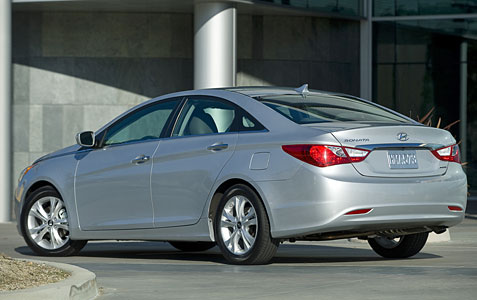Car Review: 2013 Hyundai Sonata Limited

When Hyundai released the latest Sonata a few years ago, the design was cutting edge, and now that the current design is running close to the end of its cycle, the design still holds true to this day. For 2013, Sonata built on its trailblazing recipe of high-design and high fuel efficiency with more features, higher value and better residual value than ever before. That’s important, as the midsize segment is more competitive than ever, with new competitors borrowing pages from the Sonata playbook with improved fuel economy and design.
First and foremost, you can’t help but notice the panoramic sunroof which is now part of the Limited Premium Package for 2013 as tested. Fluidic Sculpture is a consistent, cohesive design language that is used throughout the entire Hyundai showroom. It considers the interplay of natural, fluid elements with more rigid surfaces and structures to create the illusion of constant motion.
The exterior of the Sonata is long, light and low. The high beltline allows for a long, sleek roofline accented by a third window. A monoform side profile includes flowing lines highlighted by a Hyundai signature chrome accent that spans the length of the car. Normally, this type of trim is only found around the windows. On the Sonata, this trim extends out from the headlamps, juts up along the hood and through the beltline. The face is bold with a large powerful chrome grille and headlamps that integrate precise details. The stance is completed by 17-inch alloy wheels on our Limited edition. It’s amazing how the Sonata design has influenced competitors and reshaped the midsize sedan marketplace.
The sleek design, combined with Hyundai’s expertise in interior packaging, delivers class-leading interior comfort, functionality and practicality. A sleek roofline typically compromises headroom and interior volume, but at 120.2 cubic feet, the Sonata has more interior volume than many of its key competitors. It is so spacious that Sonata continues to be classified by the Environmental Protection Agency (EPA) as a large car, truly a “class above” other categorized midsize cars. The Sonata shines even in trunk volume, with 16.4 cu. ft. of trunk space that gives it a 6.1 percent advantage over direct rivals. Our test model was upscale and loaded with features, including leather seating surfaces with heated front and rear seats, power driver seat with power lumbar support, leather wrapped steering wheel and shift knob, XM Satellite radio, Dimension AM/FM/CD-MP3 with iPod/USB input, HD Radio technology with multicasting, integrated Bluetooth hands free phone system, navigation with high resolution touchscreen display, rear backup camera, and a booming and crystal clear Infinity premium audio system with subwoofer and amplifier.

The 2013 Sonata is powered by the original Theta II GDI 2.4-liter four-cylinder engine with a Gasoline Direct-Injection (GDI) fuel delivery system, which contributes to improved fuel efficiency and lower emissions. This shorter, more direct path of fuel delivery allows for greater control of the fuel mixture at the optimum moment, thus improving efficiency. The fuel is injected by a camshaft-driven, high pressure pump that operates at pressures up to 2,175 psi. Direct injection also utilizes a higher than normal 11.3:1 compression ratio for increased power. The pistons are “dished” to increase combustion efficiency in the cylinder. This power plant still delivers best-in-class fuel economy, best-in-class four-cylinder horsepower, and best-in-class torque more than two years after its initial introduction.
Sonata delivers an impressive 24 mpg city/35 mpg estimated highway fuel economy rating with the standard six-speed automatic transmission with SHIFTRONIC. The horsepower and torque ratings for the Theta II GDI are 198 horsepower and 184 lb.-ft. of torque. In the SE trim, which includes a standard dual exhaust, the engine delivers 200 horsepower and 186 lb.-ft. of torque. This high-tech, all-aluminum, 16-valve engine features Dual Continuously Variable Valve Timing (DCVVT) and a Variable Induction System (VIS) for better engine breathing. A version of this engine also meets Partial Zero Emission Vehicle (PZEV) standards. An advanced four-wheel independent suspension system combines a supple ride with precise handling and steering response for Sonata GLS, Limited and Hybrid models. Sonata uses MacPherson strut front and multi-link rear suspension systems with increased travel for improved wheel control and a smoother ride. All four wheels are controlled by coil springs, fade-resistant dual flow dampers and stabilizer bars. The suspension has been optimized to keep the vehicle flat during cornering and provide quick turn-in response. The rear suspension uses aluminum components to reduce weight and improve suspension performance. The GLS, Limited and Hybrid models also use advanced low-rolling resistance tires to improve fuel economy while maintaining good ride and handling performance.
The 2013 Hyundai Sonata Limited continues to improve on an already top-notch car in all aspects for review. We found the sleek design, roomy and well-appointed cabin, and 35mpg fuel efficiency to be quite a bargain for the sticker price as tested of $29,655. Hyundai has been very successful at going upscale without going over the top in pricing, and that is what we can value in this business. Safety has also been a priority with the Hyundai Sonata, as the car is rich in ultra-high-strength steel, leading to world-class body rigidity. The Sonata is 25 percent stiffer in torsion and 19 percent stiffer in bending rigidity than its predecessor, yet it is lighter than many midsize sedans while offering more interior room. This focus on power-to-weight ratio pays dividends across the board. The Sonata owes its ability to deliver both strong performance and excellent fuel economy in great part to its impressive power-to-weight efficiency.







